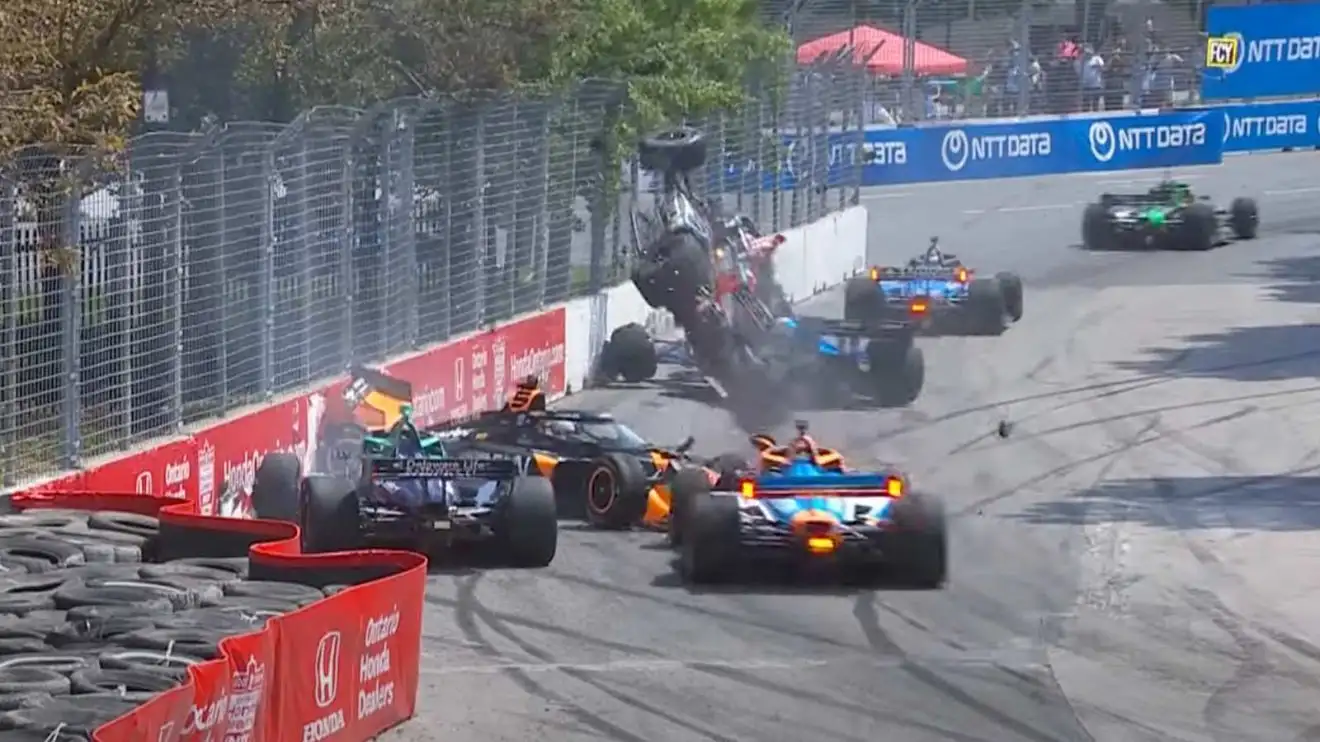
After a violent late-race collision in Toronto that left five cars piled up, one driver airborne, and one unanswered question as the checkered flag flew: Where was the yellow flag?, the IndyCar world is in shock.
In the closing moments of the Ontario Honda Dealers Indy Toronto race, Arrow McLaren driver Pato O’Ward lost control of his vehicle and was only a passenger when four further cars collided with his Chevrolet. Gavin Ward, the manager of the McLaren team, expressed his disgust over the episode, which fortunately resulted in everyone leaving unharmed.
The yellow flag was supposed to be where?
During IndyCar’s Toronto race, numerous spectators, drivers, and team members wondered, “Where was the yellow flag?” when one car crashed into another.
Driver Pato O’Ward of Arrow McLaren lost control of his Chevrolet with 13 laps left in the race, crashing awkwardly into the Turn 1 barriers. Marcus Ericsson followed closely and was unable to evade the Chevy, crashing into O’Ward’s back end and managing to decelerate his vehicle barely in time to avoid a catastrophic impact.
Sadly, the hits didn’t stop coming. Next was Pietro Fittipaldi, who gained many feet of air by driving over O’Ward’s car’s nose.
However, Santino Ferrucci’s A. J. Foyt Chevrolet took the worst of it. By effectively using O’Ward’s as a launch pad, his car propelled him into the air. The car bounced back upside down onto the track after the bottom scraped the catch netting.
The fact that O’Ward’s Arrow McLaren teammate Nolan Siegel crashed into the front of the motionless No. 6 moments later only served to exacerbate the damage.
Where was the yellow flag, though?
After his crash, O’Ward remarked, “I am so surprised that they did not call a yellow, as you are just calling for a massive shunt.”
Before revealing what was going to happen to everyone, there was a good five seconds of silence. I’m relieved that everyone who was a part of it is alright. I apologize to the team.
Gavin Ward, the manager of the Arrow McLaren team, offered additional criticism, which he shared with Motorsport.com.
“We all know how dangerous it is when a car gets up in the catch fencing in any racing series, so that was my main concern,” Ward stated.
“I’m just relieved Santino is okay; things could have turned out much worse.”
“I’m sick from what happened. The yellow seemed unusually late to Pato. I haven’t seen Theo (Pourchaire, his teammate), but we believed he did not notice a yellow. We’ll watch his video again.
“After watching our No. 6 car footage (Siegel), it is clear that there was no yellow visible when he turned the bend into Turn 1. There will undoubtedly be differences of opinion, but I think the show should consider how they may improve on that.
Employees from the IndyCar series also talked with RACER, informing reporter Marshall Pruett that the yellow had been activated following Ericsson’s collision with O’Ward and prior to Fittipaldi and Ferrucci’s touch.
That gets us back to the comment from Gavin Ward, though: although the series may have issued a full-course yellow, the drivers speeding into Turn 1 were oblivious to it.
Any modification to the race’s flag status in IndyCar results in a corresponding color change for both of the track’s LED panels, which are also visible on the driver’s steering wheel.
However, a number of drivers, including Pietro Fittipaldi and Santino Ferrucci, expressed worry that they failed to notice any yellow flags. Fittipaldi informed RACER that he had not seen any signs of an impending collision, and Ferrucci said that not even his spotters had noticed the collision.
Concerns concerning track visibility as well as flag activation time are raised by the whole scenario. There was no guarantee that drivers on the tight and challenging Toronto street circuit, where LED panels are difficult to spot and even an FCY display on the steering wheel may take a millisecond too long to register, would have known that an FCY had been activated in the instant following Ericsson’s crash.
IndyCar has pledged to investigate all aspects of the collision and examine as many driver onboards as possible over the month-long break until the next race to see exactly what went wrong and how it can be fixed going forward.